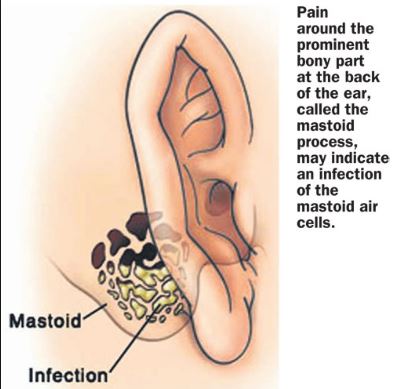When the mastoid cells become infected or inflamed, often as a result of an unresolved middle ear infection (otitis media), mastoiditis can develop. Because so many vital structures pass through the mastoid, infection may spread outside of the mastoid bone and cause serious health complications.
Acute mastoiditis typically affects children, but adults can also be affected.
Some people have chronic mastoiditis, an ongoing infection of the middle ear and mastoid that causes persistent drainage from the ear.

Mastoiditis Causes
As mentioned above, mastoiditis most often develops as a result of a middle ear infection. Bacteria from the middle ear can travel into the air cells of the mastoid bone. Less commonly, a growing collection of skin cells called a cholesteatoma, may block drainage of the ear, leading to mastoiditis.
Mastoiditis Symptoms
Mastoiditis symptoms may include:
- Fever, irritability, and lethargy
- Swelling of the ear lobe
- Redness and tenderness behind the ear
- Drainage from the ear
- Bulging and drooping of the ear
The symptoms of mastoiditis are similar to those of an ear infection. They include:
- drainage from the affected ear
- ear pain
- fever
- headache
- hearing loss in the affected ear
- redness, swelling, and tenderness behind the affected ear
In some cases, mastoiditis may result in the development of a brain abscess or other complications involving your skull. The symptoms of these conditions include severe headaches and swelling behind your eyes. This swelling is known as papilledema.
Mastoiditis Treatments
Antibiotic therapy is the mainstay of treatment for both acute and chronic mastoiditis.
If you or your child is diagnosed with acute mastoiditis, you may be put in the hospital to receive treatment and care by an otolaryngologist, a doctor who specializes in ear, nose, and throat disorders. Antibiotics will be given through an IV (intravenous line) to treat the infection.
Surgery may also be needed to drain the fluid from the middle ear, called a myringotomy. During a myringotomy, the doctor makes a small hole in the eardrum to drain the fluid and relieve pressure from the middle ear. A small tube may be inserted into the middle ear to to keep the hole from closing so as to allow for continued drainage. Typically, the tube will fall out on its own after six to 12 months.
If the symptoms don’t quickly improve on IV antibiotics, or complications, like an abscess or bone erosion are present, surgery to remove the infected mastoid bone may be recommended. This is called a mastoidectomy.
Mastoiditis Complications
Mastoiditis complications may include:
- Facial paralysis
- Nausea, vomiting, vertigo (labyrinthitis)
- Hearing loss
- Brain abscess or meningitis
- Vision changes or headaches (blood clots in the brain)

Post a comment